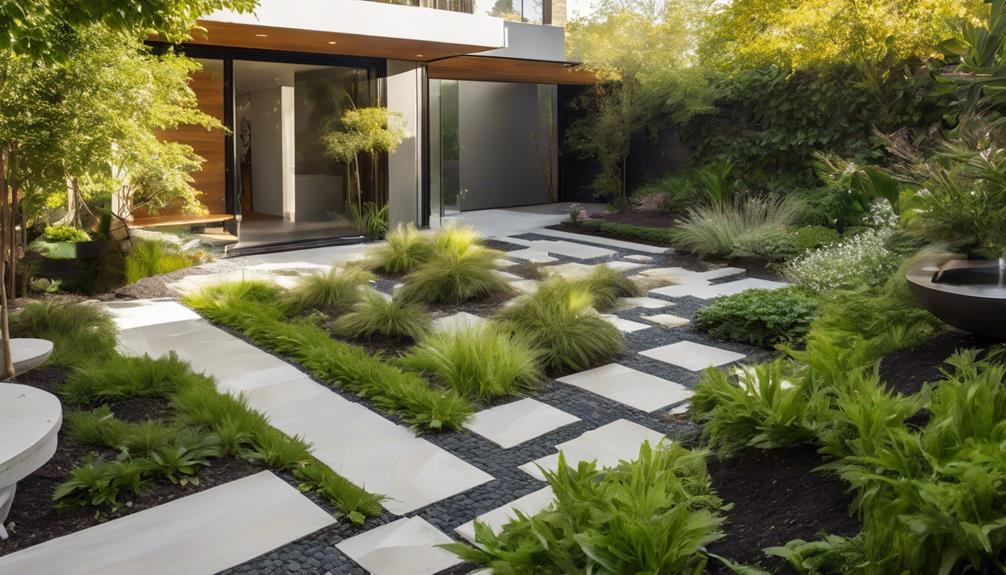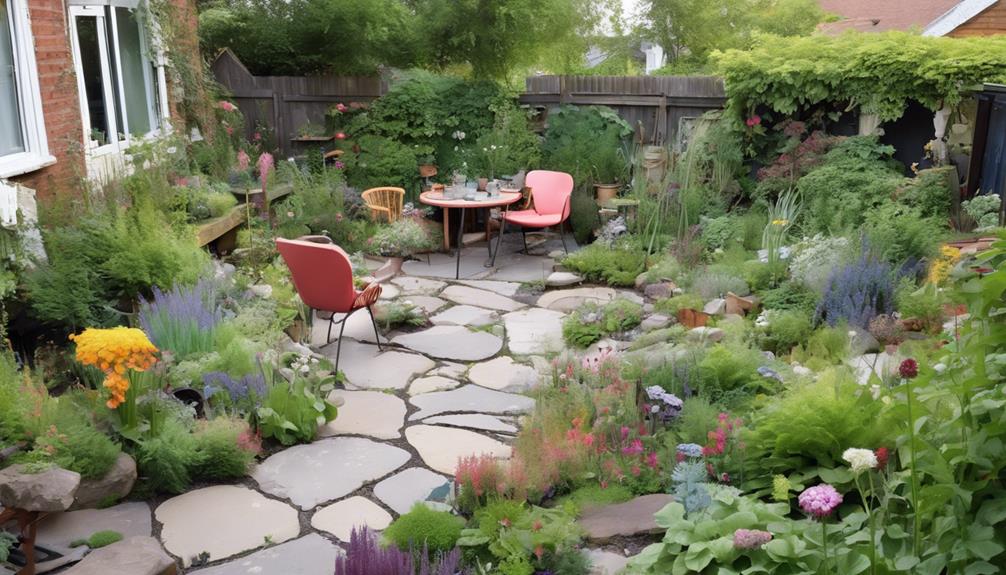
What Are Customized Plans for Unique Gardens?
15 January 2025Why Is Soil Testing Crucial Before Turf Laying?
15 January 2025The top modern garden design trends emphasise sustainability, technological integration, and biodiversity.
Sustainable practices include choosing native plants, utilising organic materials, and enhancing soil health.
Vertical gardening techniques optimise limited space while improving air quality.
Designers are focusing on multifunctional outdoor areas that blend aesthetics with leisure space.
Technology is essential, featuring smart irrigation systems and automated pest management tools for efficient gardening.
Furthermore, increased biodiversity supports local ecosystems and reduces maintenance needs.
For further insights into these creative trends and how to apply them, further exploration is encouraged.
Current Trends in Garden Design
As we explore the current trends in garden design, sustainable plant choices and vertical gardening techniques emerge as prominent themes.
Gardeners are increasingly prioritising eco-friendly options that enhance biodiversity while requiring fewer resources.
Simultaneously, vertical gardening is gaining popularity, offering creative solutions for maximising space and creating visually striking landscapes.
Sustainable Plant Choices
While the demand for eco-friendly gardening practices continues to rise, sustainable plant choices have emerged as a cornerstone of modern garden design.
Selecting native and drought-tolerant species not only conserves water but also supports local ecosystems by providing habitats for indigenous wildlife.
Moreover, incorporating perennials over annuals reduces the need for frequent replanting, thereby minimising waste and labour.
Emphasising biodiversity through a varied plant palette improves resilience against pests and diseases, promoting a healthier garden in general.
In addition, utilising organic fertilisers and pest management techniques aligns with sustainable practices, fostering soil health and reducing chemical runoff.
As gardeners become increasingly conscientious, these sustainable plant choices not only reflect personal values but also contribute to a more sustainable future.
Vertical Gardening Techniques
Vertical gardening techniques have gained significant traction in contemporary garden design, offering creative solutions for maximising space in urban environments. This approach not only enhances aesthetic appeal but also promotes biodiversity and sustainability.
Techniques such as living walls, trellises, and vertical planters enable the cultivation of a range of plants, from herbs to ornamental species, effectively utilising limited ground space.
Additionally, hydroponic and aeroponic systems have emerged, facilitating soil-less gardening that optimises water usage and nutrient delivery. The implementation of vertical gardens can improve air quality and provide thermal insulation, reflecting a deeper commitment to ecological design.
As urban populations grow, mastering vertical gardening becomes crucial for landscape architects and designers aiming to create functional, green spaces that harmonise with urban living.
Sustainable Materials and Practices
Sustainable materials and practices are becoming crucial in modern garden design, focusing on ecological balance and resource efficiency.
The selection of native plants promotes biodiversity and reduces water consumption, while vertical gardening techniques enhance space and encourage urban greening.
Furthermore, the implementation of smart irrigation systems ensures optimal water usage, further enhancing sustainability in gardening practices.
Native Plant Selection
Selecting native plants is a crucial element in modern garden design, particularly for those seeking sustainable materials and practices.
By prioritising flora indigenous to the local ecosystem, gardeners can improve biodiversity, reduce water consumption, and minimise maintenance efforts. Native plants are well-adapted to the local climate and soil conditions, making them resilient choices for sustainable landscaping.
Consider the following benefits of integrating native plant selection:
- Biodiversity improvement: Supports local wildlife, including pollinators.
- Water conservation: Requires less irrigation once established.
- Soil health enhancement: Promotes natural soil fertility and structure.
- Reduced chemical use: Naturally resistant to local pests and diseases.
Incorporating native plants not only fosters ecological balance but also reflects a commitment to sustainable gardening practices.
Vertical Gardening Techniques
Embracing vertical gardening techniques has gained popularity among modern gardeners seeking to optimise space and enhance aesthetic appeal.
These methods not only improve visual interest but also promote sustainable practices, making them ideal for eco-conscious enthusiasts.
Key techniques include:
- Living Walls: Utilising modular systems that integrate plants into wall structures, creating lush, green backdrops.
- Vertical Planters: Employing stacked pots or tiered planters to maximise planting surface area without consuming ground space.
- Trellises and Arbours: Supporting climbing plants to create natural privacy screens while adding height to garden designs.
- Hanging Gardens: Suspended planters that allow for creative arrangements, perfect for small spaces and urban environments.
These innovative approaches elevate gardening while prioritising sustainability and efficient resource use.
Smart Irrigation Systems
Efficient water management is crucial for modern garden design, and smart irrigation systems are at the forefront of this movement.
These groundbreaking systems employ advanced technology to optimise water usage, ensuring that plants receive the precise hydration they require while minimising waste. As gardeners increasingly prioritise sustainability, smart irrigation solutions have emerged as critical tools for creating resilient landscapes.
Key features of these systems include:
- Soil moisture sensors that monitor hydration levels in real time.
- Weather-based controllers that adjust watering schedules according to local conditions.
- Mobile app integration for remote management and monitoring.
- Drip irrigation technology that delivers water directly to the roots.
Designing a Garden Layout
Designing a garden layout begins with clearly identifying the garden’s purpose, whether it be for recreation, aesthetics, or food production.
Once the purpose is established, enhancing soil health becomes essential through techniques such as composting and crop rotation.
Ultimately, implementing layered planting strategies can optimise space and create a visually appealing, thriving environment.
Identify Your Garden’s Purpose
A successful garden layout begins with a clear understanding of its purpose, as this foundational step influences every aspect of the design process.
Identifying the intended use of the garden allows for thoughtful planning and optimises functionality.
Consider the following key purposes when designing your garden:
- Recreation: Spaces for leisure activities, such as seating areas or play zones.
- Cultivation: Designated areas for growing vegetables, herbs, or flowers.
- Aesthetics: Visual appeal through landscaping, colour schemes, and ornamental plants.
- Wildlife Habitat: Features that attract and support local fauna, enhancing biodiversity.
Soil Health Enhancement Techniques
To cultivate a thriving garden, prioritising soil health is essential, as it lays the foundation for plant growth and overall garden success.
Implementing effective soil health improvement techniques can dramatically boost your garden’s productivity and resilience.
Consider the following strategies:
- Organic Matter Supplement: Incorporate compost and mulch to enrich the soil structure and retain moisture.
- Cover Cropping: Plant cover crops to prevent erosion, suppress weeds, and fix nitrogen in the soil.
- Soil Testing: Regularly test soil pH and nutrient levels to tailor amendments specifically to your garden’s needs.
- Crop Rotation: Rotate plant families annually to mitigate pest build-up and maintain nutrient balance.
Layered Planting Strategies
How can layered planting improve the visual appeal and functionality of a garden?
Layered planting strategies create depth and intrigue, transforming flat landscapes into dynamic, engaging spaces. By arranging plants in tiers, gardeners can optimise light, encourage biodiversity, and enhance seasonal interest. This technique not only elevates aesthetics but also promotes healthier ecosystems.
- Height Variation: Utilise tall plants at the back and shorter ones at the front for visual balance.
- Seasonal Interest: Select plants that bloom at different times to ensure year-round colour.
- Microclimates: Create sheltered areas that support diverse plant species.
- Easier Maintenance: Group plants with similar needs to streamline care and irrigation.
Implementing layered planting strategies can significantly enrich your garden’s design and functionality.
Enhanced Biodiversity in Gardens
Many gardeners are increasingly recognising the importance of enhanced biodiversity in their outdoor spaces, understanding that diverse ecosystems contribute to healthier gardens. By incorporating a variety of plants, pollinators, and wildlife habitats, gardeners can create resilient environments that thrive. The following table highlights key aspects and benefits of augmented biodiversity:
| Aspect | Benefits | Implementation Strategies |
|---|---|---|
| Plant Variety | Increases resilience to pests | Introduce native species |
| Pollinator Support | Augments fruit and seed production | Create pollinator gardens |
| Soil Health | Improves nutrient cycling | Utilise cover crops and mulching |
| Wildlife Habitat | Promotes ecological balance | Install birdhouses and water features |
Emphasising biodiversity not only enriches the garden aesthetically but also fosters sustainable practices that can endure environmental changes.
Technology-Driven Garden Management
Technology-driven garden management is revolutionising how gardeners maintain their spaces.
Automated pest monitoring systems and drone-assisted garden surveillance offer new levels of efficiency and insight, whilst soil nutrient monitoring applications ensure optimal plant health.
These innovations not only enhance productivity but also promote sustainable gardening practices.
Automated Pest Monitoring Systems
Harnessing the power of technology, automated pest monitoring systems have emerged as a crucial tool in modern garden management.
These groundbreaking systems provide real-time data on pest activity, enabling gardeners to implement proactive measures and reduce crop damage. By leveraging advanced sensors and artificial intelligence, they deliver precise insights that improve decision-making.
Key features of automated pest monitoring systems include:
- Real-time alerts to notify gardeners of pest presence.
- Data analytics for identifying patterns and trends in pest behaviour.
- Integration with irrigation and fertilisation systems for optimised resource use.
- User-friendly interfaces that facilitate effortless monitoring and management.
As a result, these systems not only safeguard plants but also promote sustainable gardening practices.
Drone-Assisted Garden Monitoring
As technology continues to reshape gardening practices, drone-assisted garden monitoring has emerged as a powerful tool for enhancing garden management.
This innovative approach utilises aerial imagery and data analysis to provide gardeners with critical insights, enabling precise decision-making and resource optimisation.
Key benefits of drone-assisted monitoring include:
- Real-time surveillance: Obtain immediate visual data on plant health and garden conditions.
- Efficient resource allocation: Identify areas needing water or nutrients, thereby reducing waste.
- Pest detection: Spot infestations early, allowing for timely intervention.
- Growth tracking: Monitor plant growth patterns to inform future planting strategies.
Soil Nutrient Monitoring Application
Soil nutrient monitoring applications are revolutionising garden management by providing real-time data on soil health.
These advanced tools empower gardeners to make informed decisions, enhancing plant growth and yield. By integrating technology into traditional horticulture, these applications facilitate precision agriculture practices.
Key features of soil nutrient monitoring applications include:
- Real-time nutrient analysis: Instant feedback on nitrogen, phosphorus, and potassium levels.
- pH level monitoring: Ensures soil acidity or alkalinity is within ideal ranges for plant health.
- Moisture detection: Prevents over or under-watering by assessing soil moisture levels.
- Customisable recommendations: Tailored advice on fertilisation and soil amendments based on specific plant needs.
With these capabilities, gardeners can achieve mastery over their soil’s health, leading to thriving, sustainable gardens.
Pest Control Strategies Explained
Effective pest control is crucial for maintaining a thriving garden.
Strategies such as companion planting, integrated pest management techniques, and organic deterrent methods offer environmentally friendly solutions to combat pests.
Companion Planting for Pest Control
Companion planting has emerged as a valuable strategy in modern garden design, particularly for pest control. This method involves strategically pairing plants to improve growth and deter pests naturally. By understanding plant relationships, gardeners can cultivate more resilient ecosystems.
Consider these effective companion planting combinations:
- Marigolds: Deter nematodes and aphids when planted alongside vegetables.
- Basil: Enhances the growth of tomatoes while repelling fruit flies and mosquitoes.
- Nasturtiums: Act as a trap crop for aphids, thereby protecting nearby plants.
- Garlic: Repels a variety of pests, including beetles and aphids, when interplanted with other crops.
Implementing these combinations not only promotes biodiversity but also reduces reliance on chemical pesticides, fostering a healthier garden environment.
Integrated Pest Management Techniques
In the realm of sustainable gardening, integrated pest management (IPM) techniques provide a comprehensive approach to controlling pests while minimising environmental impact.
IPM combines a variety of strategies to manage pest populations effectively, promoting ecological balance.
Key components of IPM include:
- Biological Control: Utilising natural predators or parasites to reduce pest numbers.
- Cultural Practices: Implementing crop rotation and proper sanitation to disrupt pest life cycles.
- Physical Barriers: Employing nets, traps, or insect-proof structures to prevent pest access.
- Monitoring and Assessment: Regularly evaluating pest populations to make informed management decisions.
Organic Pest Deterrent Methods
Numerous organic pest deterrent methods have emerged as viable solutions for gardeners seeking to protect their plants without resorting to synthetic chemicals.
These methods not only safeguard plants but also promote ecological balance.
Here are four effective strategies:
- Companion Planting: Utilise specific plant combinations to repel pests naturally.
- Neem Oil: Derived from the seeds of the neem tree, it disrupts the life cycle of various insects.
- Diatomaceous Earth: This natural powder damages the exoskeletons of pests, leading to their dehydration.
- Garlic Spray: A homemade solution that serves as a potent repellent due to its strong odour.
Incorporating these organic methods allows gardeners to foster a healthier ecosystem while maintaining the integrity of their gardens.
Why Choose TKL Birmingham Gardener
Choosing TKL Birmingham Gardener for your landscaping needs guarantees a blend of expertise and personalised service that stands out in the current competitive market.
With a keen understanding of modern garden design trends, TKL integrates innovative techniques with traditional craftsmanship, ensuring your outdoor space is both functional and aesthetically pleasing.
The team’s commitment to sustainability and eco-friendly practices reflects a growing awareness of environmental impact, making them a responsible choice for discerning clients.
Furthermore, TKL Birmingham Gardener takes pride in meticulous attention to detail, from the initial consultation to project completion, fostering a collaborative relationship that empowers clients.
Common Garden Maintenance Questions
Maintaining a garden can often raise a variety of questions, especially for those new to landscaping or gardening. Common inquiries include how to effectively manage weeds, the ideal frequency for watering, and the best practices for pruning.
Understanding the lifecycle of plants is vital; for instance, many perennials require deadheading to encourage further blooming. Furthermore, gardeners often seek clarity on fertilisation techniques, specifically the balance between organic and synthetic options.
Pest management is another frequent concern, as identifying the right approach ensures the health of both plants and beneficial insects.
Plan Seasonal Planting Schedules
A well-timed planting schedule is vital for maximising the potential of your garden throughout the year. By planning seasonal planting, you can ensure peak growth, colour, and yield.
This strategic approach not only enhances the aesthetic appeal but also aligns with the natural rhythms of your environment.
Consider these fundamental elements for an effective planting schedule:
- Climate Zone: Understand your local climate to select appropriate plants.
- Crop Rotation: Rotate crops to maintain soil health and reduce pest incidence.
- Companion Planting: Utilise beneficial plant combinations for pest control and growth improvement.
- Seasonal Blooms: Choose a variety of plants that bloom at different times for continuous visual interest.
Implementing these strategies will elevate your gardening expertise and yield impressive results.




